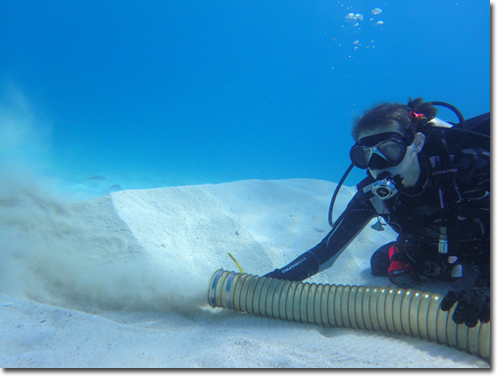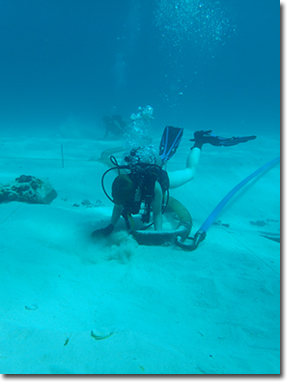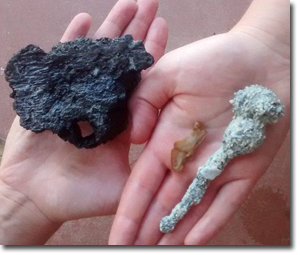Dredging By Kristina Fricker 28 May 2016

Olivia Thomas tending the spoil pile (photo by J. McKinnon 2016).

Kristina Fricker excavating Unit 5, Pillar Dollar Wreck, Biscayne Bay National Park (photo by J. McKinnon 2016)
We spent the majority of our dive time cleaning the Ďspoilí (sand that does not pertain to the original wrecking of the ship) off of the newly created Unit 5. We descended in teams of three; one person to hand fan sand into the dredge, one to watch the end of the dredge and the refuse pile, and a person to monitor and time the whole operation. I spent the day working with Annie and Allyson, and we switched between the three roles every 20 minutes.
Lesson learnedódredge hoses have a mind of their own. Also, donít let your dive computer near the dredge head (donít worry, I didnít lose my computer, but I got close).
The dredge requires significantly more physical exertion than photos would lead you to believe; the dredge head is quite heavy and on the other end, the force of the water leaving the hose tends to push the diver babysitting it across the site.

Artifacts found on site. On the left a large chunk of wood with a fastener hole; in the middle an animal bone; on the right a whole fastener (photo by K. Fricker 2016).
By the end of the day, the teams removed close to 1.5 meters of sand across the 2mx6m unit. This was also the first day we started collecting artifacts. My team recovered three artifacts; a small bone, a piece of wood with a fastener hole, and a metal fastener.
On a more humorous (or possibly morbid) note, small schools of fish will wait by the dredge spoil to catch snacks. The unit had a number of long black worms that bury themselves in the sand. The dredge would suck up the worms and spit them out on the spoil pile, at which point the fish would descend as a group and rip the worms apart. Kind of disgusting? Maybe. Fascinating to watch? Completely, but I digress.
Overall, Iíve been incredibly impressed with the quality of preservation of the wooden hull remains of the ship. On previous projects Iíve handled wooden remains from wrecks that were never conserved; they were simply removed from the salt water and set on a shelf. These unconserved pieces would disintegrate in my hand. The wooden remains weíre working with however are incredibly well preserved and solid. The difference in preservation still astounds me; wooden remains can last for hundreds of years underwater, but an unconserved piece will fall apart within a few decades.

Frames and the keel identified in the last field season and uncovered this year by the hard work of our National Park Service hosts (photo by J. McKinnon 2016).
Previous Next

